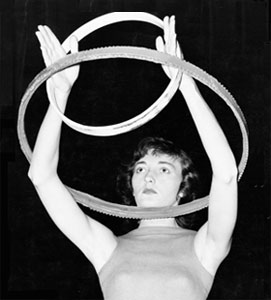![]()
Historical Images and Videos
Previously Featured on Bearnstow Journal
![]()
 |
To give his Playhouse students performing experience Nikolais produced dance plays for children. The first produced at the Playhouse (pictured left) was the Fable of the Donkey (Aesop) in 1948 (originally created in Colorado Springs in 1946).
![]()
Fable was followed by such varied productions as The Lobster Quadrille (from Lewis Carroll’s Alice’s Adventures in Wonderland), 1949, and numerous original works in the 1950s: Indian Sun, St. George and the Dragon, Tale of the Winds, and Merry-Go-Elsewhere. These dance plays were presented not only at the Playhouse but also in school auditoriums throughout the Metropolitan area and in such prestigious venues as the American Museum of Natural History in New York City, the Cincinnati Museum of Natural History, and the Philadelphia Academy of Music.
![]()
Pictured from left to right are: Martha Howe, Murray Louis, Nancy Robb, Gladys Bailin (on the floor), Luke Bragg and Al Sernka (with arms raised), Sheldon Ossosky (the donkey), Jack Spencer (on the floor), Toby Glanternick (with her hair held up), Ruth Grauert, Anita Lynn, Phyllis Lamhut, and Gino Mortenghi.
Photo: Playhouse Dance Company, ca. 1950–51; Courtesy Nikolais-Louis Dance Collection, University of Ohio, Athens
Click image to enlarge.
 Click photo to enlarge |
The Lobster Quadrille (from Lewis Carroll’s Alice’s Adventures in Wonderland), music by Freda Miller, premiere November 19, 1949, American Museum of Natural History, New York City, for the New York Times Third Annual Boys & Girls Book Fair.
![]()
Pictured are Phyllis Lamhut (Alice) with Jack Spencer (Gryphon) and Frances Mortenghi (Mock Turtle), at other times played by Carl Morris and Betty Osgood.
Photo: David S. Berlin ~ Nikolais-Louis Dance Collection
![]()
To give his Playhouse students performing experience Nikolais produced dance plays for children. The first of these produced at the Playhouse was the Fable of the Donkey (Aesop) in 1948, followed by The Lobster Quadrille and other works in the 1950s: Indian Sun, St. George and the Dragon, Tale of the Winds, and Merry-Go-Elsewhere.
![]()
In addition to the Playhouse, the plays were presented in school auditoriums throughout the Metropolitan area and in such prestigious venues as the American Museum of Natural History in New York City, the Cincinnati Museum of Natural History, and the Philadelphia Academy of Music.
 From left to right: Jack Spencer, Sheldon Ossosky (as the Donkey), Ruth Grauert, and Al Sernka; Phyllis Lamhut is just out of view in this photo. (Click to enlarge) Photo courtesy of the Nikolais-Louis Dance Collection, Mahn Center for Archives and Special Collections, Ohio University Libraries |
The Fable of the Donkey, after the Aesop tale, was written and produced during the summer of 1948 by Nikolais where he was working under Hanya Holm in Colorado. He reproduced it at the Henry Street Playhouse for the 1948 Christmas/Chanukah celebration. It is this production that is pictured here. It was perhaps the first dance that Nikolais presented at the Playhouse. Fable remained in the Playhouse Dance Company repertory for many years.
![]()
Fable was followed by such varied productions as The Lobster Quadrille (from Lewis Carroll’s Alice’s Adventures in Wonderland) in 1949, and numerous original works in the 1950s: Indian Sun, St. George and the Dragon, Tale of the Winds, and Merry-Go-Elsewhere.
 |
Photo of Alwin Nikolais and Hanya Holm in 1949 at Colorado College, Colorado Springs, where Nik spent his summers as Hanya’s teaching assistant following World War II.
While studying dance for three summers at Bennington College, 1938–40, he had the opportunity to study with Hanya Holm, who became one of his most influential teachers. Besides opening his own school in Hartford, he also performed as a dancer in the Hanya Holm Dance Company. After a brief interruption in his training when he joined the army for World War II, Nikolais moved to New York City and became Holm’s assistant at her Colorado College summer residencies. It was here he met Murray Louis. He was appointed director of the Henry Street Playhouse in 1948.
 |
Pictured is a class at the Henry Street Playhouse in 1949. Identified persons are, at lower left, Alwin Nikolais; back row standing: Ruth Grauert, Luke Bragg, and Martha Howe; second row: ***, ***, and Sheldon Ossosky; seated in front: Anita Lynn, Phyllis Lamhut, Nancy Robb, and ***. Dancers in motion are Murray Louis and Gladys Bailin.
Photo courtesy Nikolais-Louis Dance Collection, University of Ohio, Athens
![]()
Click image to enlarge.
![]()
If you are able to name any unindentified person in these two class photos, please contact Webmaster.

 |
Another class photo at the Henry Street Playhouse taken in 1949. Identified persons are, on left standing: Luke Bragg, Sheldon Ossosky, and Murray Louis; front seated: Anita Lynn, Phyllis Lamhut, ***, Nancy Robb (front), Martha Howe (rear), Murray Gitlin, and ***; on right: Alwin Nikolais and Gladys Bailin.
Photo courtesy Nikolais-Louis Dance Collection, University of Ohio, Athens
Click image to enlarge
If you are able to name any unindentified person in these two class photos, please contact Webmaster.
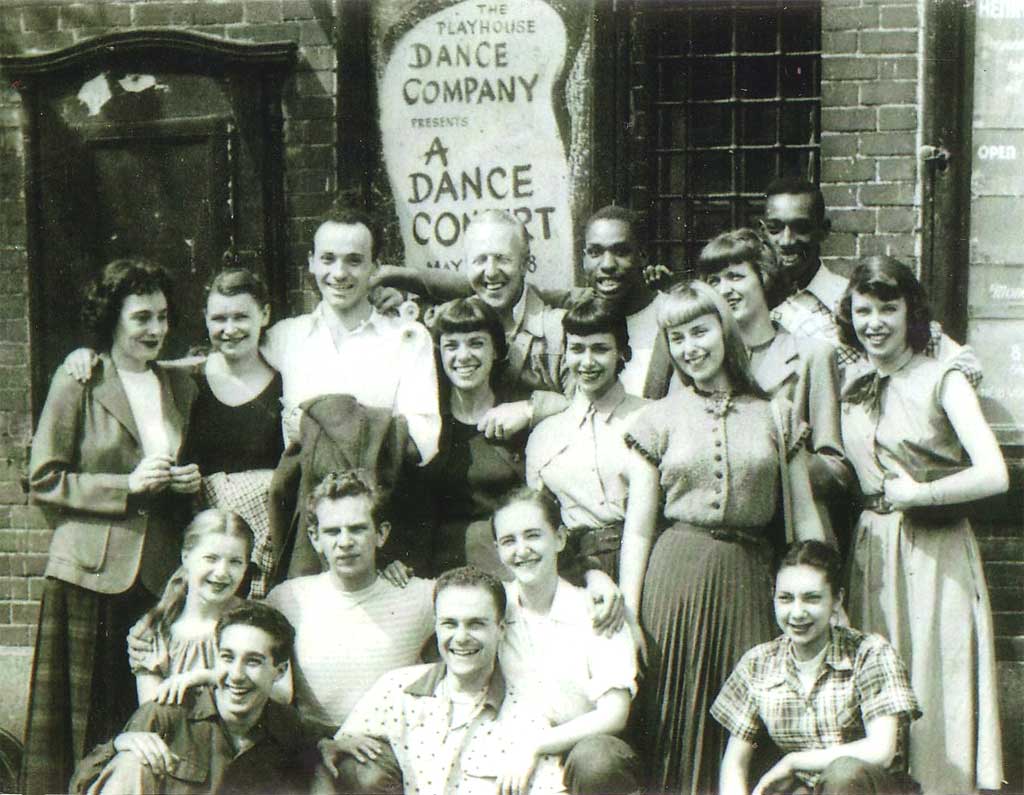 |
Pictured is the Playhouse Comany at the Henry Street Settlement Playhouse in 1953. See some of these dancers today in photos of The Horse’s Mouth, a special centennial celebration in memory of Nik. Identified persons are: Men in back row Murray Louis, Alwin Nikilais, Floyd Gaffney, and Bill Frank. Women standing: Florence Deutsch, Ellen Griegas, Debby Klein (née Cohen), Gladys Bailin, Phyllis Lamhut, Ruth Grauert, and Nancy Robb. Down front: ***, ***, ***, Billy Shulman, Lenny Landau, and ***.
Click image to enlarge
If you are able to name any unindentified person in this photo, please contact Webmaster.
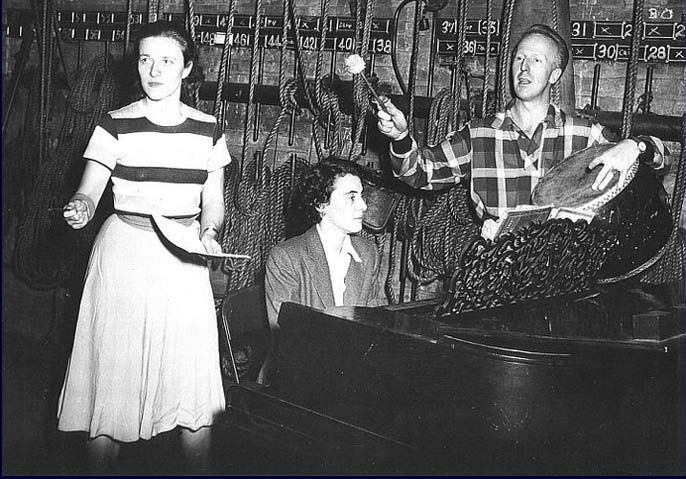 |
Backstage at the Henry Street Playhouse, early 50s. Ruth Grauert, Florence Deutsch (pianist), and Alwin Nikolais
![]()
(click photo to enlarge)
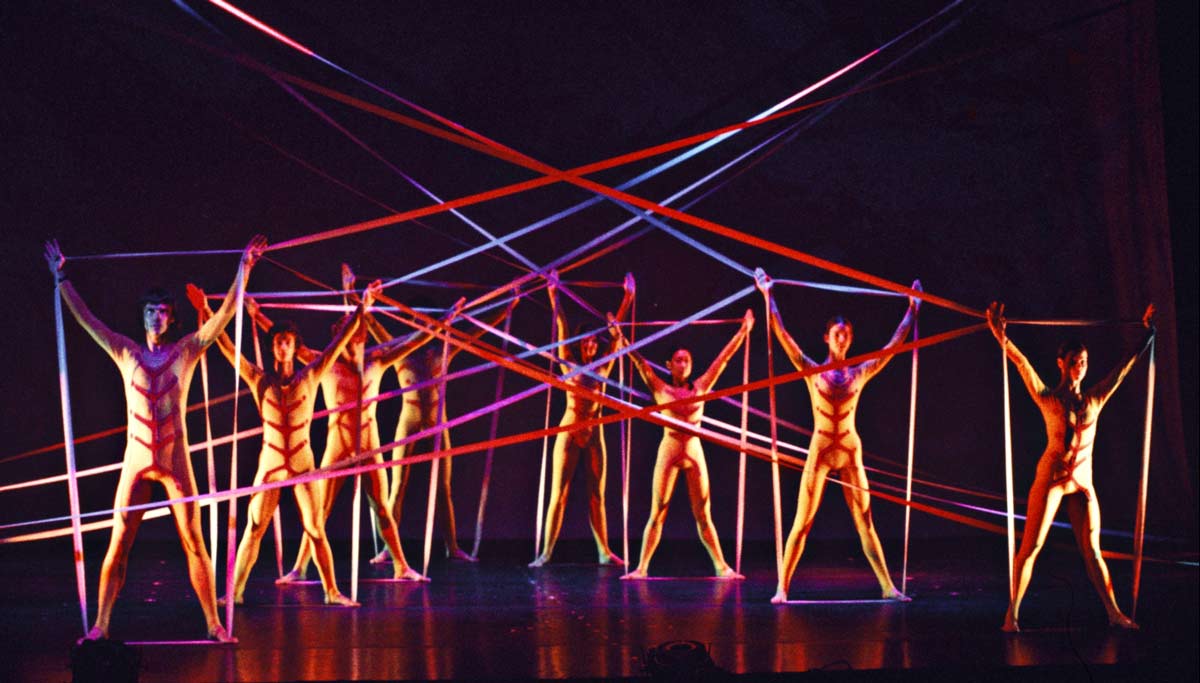 |
“Web” originally premiered at the Henry Street Settlement Playhouse on February 13, 1955, as part of the concert titled “Village of Whispers.” On December 10, 1955, it was integrated into Masks, Props and Mobiles and later reworked as a full company dance titled Tensile Involvement. It was performed on the “Steve Allen Show” on May 17, 1959. It remained in the repertory for many years, becoming one of Nikolais’s signature pieces. It often opened the evening’s concert (see photo of the 1969 moon-landing performance in Baalbeck, Lebanon). Photo of Ririe-Woodbury Company performance by Tom Caravaglia, ca. 1974 (click photo to enlarge)
![]()
See the Ririe-Woodbury Company performance video of Tensile Involvement on the left.
See also the Alwin Nikolais Dance Theater performance at the 1987 Kennedy Center Honors gala.
Dorothy Vislocky participated in the making of Nikolais’s Theater Dance for ten years, during the time of his intense explorations of space, time, shape and motion, as he incorporated sound, light, and a wide array of materials to create the magic of his theater. On July 28–August 3, 2013, Dorothy Vislocky conducted the workshop “Principles of Nikolais Theory and Composition” at Bearnstow in Mount Vernon, Maine. Dorothy passed away in October 2013; see her Memorial page.
| |||||||
 From l to r: Beverly Blossom, Murray Louis, and Bill Frank (click to enlarge) Photo courtesy of the Alwin Nikolais and Murray Louis Dance Collection, Mahn Center for Archives and Special Collections, Ohio University Libraries |
Photo of “Capes”—the finale of Kaleidoscope (premiered at the Henry Street Settlement Playhouse, 1956). “Capes” was originally part of Masks, Props & Mobiles (1953). Leotards made from crinkle knit worn for other dances in Kaleidoscope (see more images in The Theater of Alwin Nikolais by Ruth Grauert on this site) were actually painted on the dancers by the prominent Greek-American artist George Constant.
![]()
Gladys Bailin Stern recalls:
![]()
| “The cape fabric was some kind of jersey, somewhat stretchable to achieve the shapes Nik wanted to see. There were figures behind the seated ones, also holding the capes and standing on boxes. It appears that the capes were attached under the armpit and held by hand at one end, also held taut by the feet to get the tension. I'm sure we did other moves with the capes, but the one in the photo makes for elegant grandeur.” |
 From left to right: Phyllis Lamhut, Murray Louis, Gladys Balin (Stern), Beverly Schmidt (Blossom), Coral Martindale (Auburn), and Bill Frank (click photos to enlarge) |
The Bewitched premiered on March 26, 1957 at the University of Illinois at Urbana-Champaign, with music composed by Harry Partch. The prominent Greek-American artist George Constant made the props and painted the the costumes.
![]()
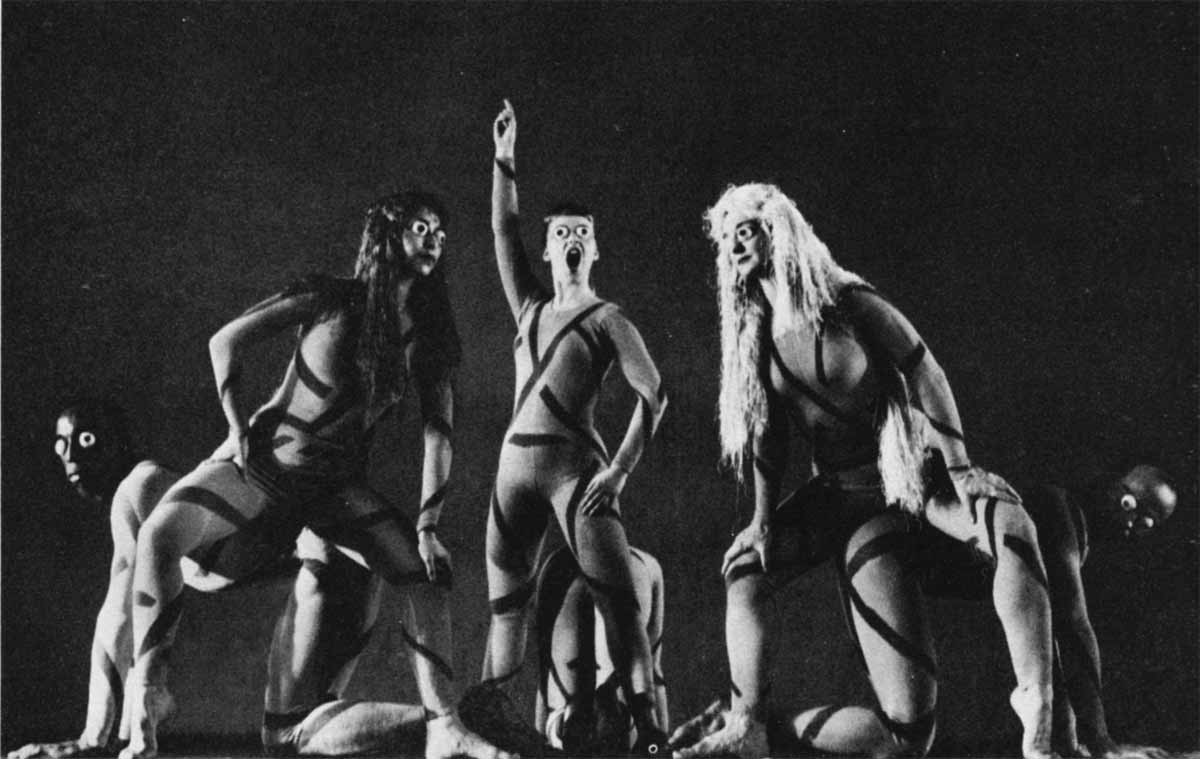
![]()
Bewittched was choreographed in several episodes; the section (above left) was called “Garden.” In another (right), called “Detectives,” dancers wore artificial eyes made of ping-pong balls (click to englarge).
Invention in Dance — Alwin Nikolais 1959
| Click arrow to begin video. |
Digitized from the A/V Geeks 16mm Archive. A/V Geeks on YouTube
 |
Photo: Nikolais Dance Theater
Click image to enlarge.
Images from Utah 1964
![]()
Charlie and Joan Woodbury owned this church building in Park City, Utah, and held dance workshops there for three years, 1964–1966, with Nik as the guest artist. In 1962 and ’63, Nik and Murray had come to teach workshops in the old dance building on campus at the University of Utah. By 1964, Charlie had finished remodeling the church, creating a studio with two glorious spaces for classes. Tandy Beal came to one of the workshops held in Park City as did Winston Gray and Maida Withers. These were great times when Nik was exploring his own philosophy and writing his book. Back then the church was called “Charlie’s Church” and sometimes “The Woodbury Church.” Now the building, which has been painted blue and turned into a condo with about 15 units, is called “The Blue Church Lodge.”
![]()
Below are a few promo shots taken by a photographer from the Tribune for a story about our workshops.
![]()
(Hold mouse over images to pause slide changes.)
 Shirley Dee Winterton, Tim Wengard, Loa Clauson, Bob Beswick, Joan Moon and Joan Woodbury (click image to enlarge) |
 |
In Galaxy, 1965, Nikolais made extensive use of blacklight. Ultraviolet light enabled him to create moving elements without revealing the mechanics of the motion.
Photo: Herbert Migdoll
Click image to enlarge.
 |
Somniloquy premiered in February 1967 at the Guggenheim Museum, whose small stage devoid of lighting instruments prompted Nik to develop miniature battery-powered Linnebach projectors, which each dancer carried. The hand-held lantern was controled with an “Ohmite” variable resister as a dimmer.
![]()
Somniloquy represents Nikolais’s first extensive use of projectors in a work. Center figures are Phyllis Lamhut and Murray Louis.
![]()
Photo: Bob Moreland (published in Time Magazine, 03/15/1968)
![]()
Click image to enlarge.
Alwin Nikolais’s Tent (1968)
This video was produced in the studio of Zweite Deutsche Fernsehn (ZDF) in Munich, Germany in 1969. Dancers: Murray Louis, Phyllis Lamhut, Carolyn Carlson, Gale Ormiston, Wanda Pruska, Robert Solomon, Sara Shelton, Michael Ballard, Emery Hermans, and Jeanette Stoner. Tech: Jon Garness, George Gracey, and James Van Abbema.
 From left to right: Robert Small, Marcia Wardell, Leslie Ditson, Anne McCleod, Helen Kent, and Michael Ballard in Proximities, 1969. (Click to enlarge) Image scanned from a 10" x 21" poster that had been inadvertently discarded and found outdoors after a period of time exposed to the elements; photographer unknown. |
|
The Murray Louis Dance Company
![]()
Proximities (originally titled The Pleasures of Proximities) premiered on January 30, 1969, at the Henry Street Playhouse. Accompanied by Brahms’ Serenade No. 2 in A, the work was said to have been a Valentine present Murray gave his company. It soon became core repertory and was performed widely on tour. Proximities was among the first of Louis group pieces to be mounted on another dance company, given to Entre-Six of Montreal in 1978.
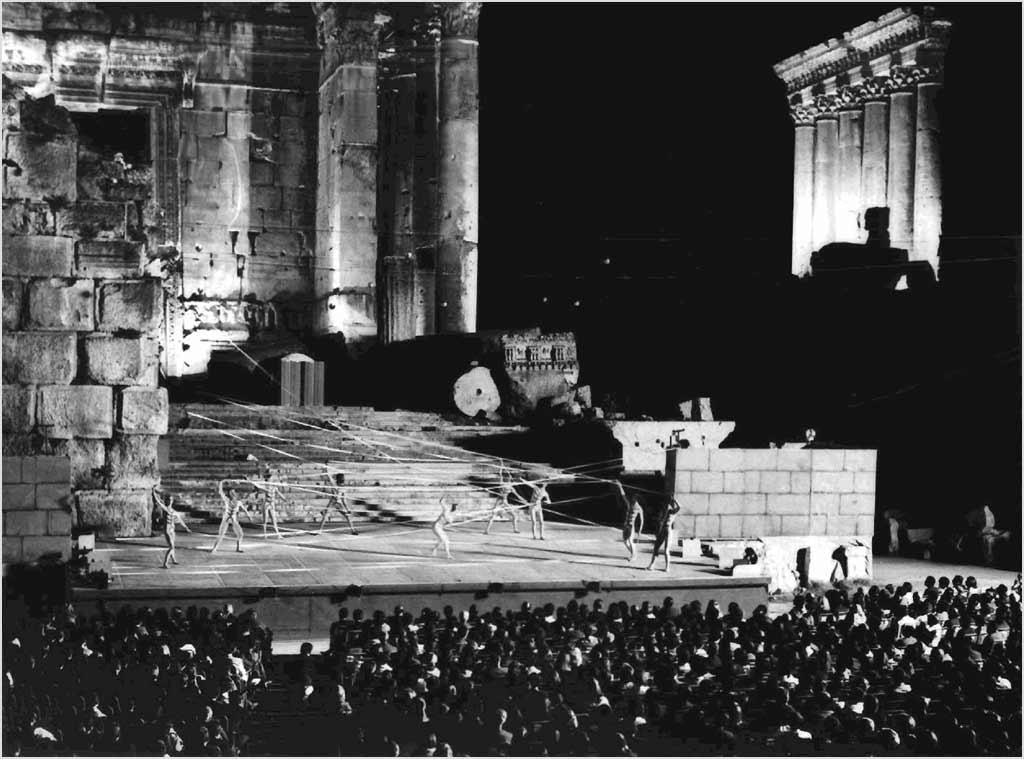 |
On July 20, 1969, the Nikolais Dance Theater opened with Tensile Involvement on the stage before the Roman Temple of Bacchus in Baalbeck, Lebanon. The performance was part of the Quatorzieme Festival International de Baalbeck. During the first intermission, the festival director came onstage to make an announcement to the audience of 5,000. In Arabic, French, and English, he told us that the Apollo 11 astronauts had just taken their first steps on the Moon. The crowd cheered. Just above the towers of the Temple of Jupiter (the six columns on the right in the photo) the crescent of the Moon was shining brightly.*
![]()
Photo courtesy Nikolais-Louis Dance Collection, University of Ohio, Athens (Click image to enlarge)
![]()
* I was there, on the crew. It was truly a “magic moment”! —Jim Van Abbema, Ed.
 (Click image to enlarge to full size.) |
in Buenos Aires, Spring Tour 1973
George Gracy found this photo, scanned it, and sent it to us. George writes:
As I recall, it was our only night off in a long time. After the show the evening before, Nik told us we had to go to this thing. The smiles you see on us all are entirely fake (except for Nik’s and Ambassador Lodge). Enjoy! Sweet Memories.
Identified from left standing: John MacFarlane, George Gracey, Suzy MacDermaid, Bill Groves, Frankie Garcia, Ann Marie Ridgway, Fred Timm, Lisbeth Bagnold, Jim Teeters, and Lynn Levine. Seated from left: Gerald Otte, Alwin Nikolais, Mrs. Francesca Braggiottie Lodge, and Ambassador John Davis Lodge. (Others are Embassy and/or cultural personnel.)Ambassador John Davis Lodge (1903–1985) was an actor turned politician. He was the 79th Governor of Connecticut, and served as U.S. Ambassador to Spain, Argentina, and Switzerland. In 1929 he married dancer and actress Francesca Braggiottie, who, with her sister, were well-known dancers in Boston after World War I. She starred in several films in the 1930s and also dubbed several (she was the first Italian voice of Greta Garbo).
Download high resolution copy of this photo (JPG) (1.6 Mb).

While on tour in 1973 in Oklahoma with the Murray Louis Dance Company, Les Ditson drew a cartoon especially for the Nikolais Dance Theater company members, who were on tour at the same time in South America. He recently disovered copies of it in his computer and sent it along. For those of us who were around at that time (and even for those who were not), there are bound to be some company members you recognize!
Click image to expand to full size.
For identification of persons download the Key (PDF)
Download a PDF copy of the full-size drawing.
| Click arrow to begin video. |
In this November 1974, CUNY TV, City University Television production, recently digitized and rebroadcast, Nikolais discusses the development of his art and aesthetic.
Q: Is creativity a kind of compulsion with you?
A: I think it is; an artist has no choice, you have no choice. If someone were to ask me, “Shall I be a dancer?” I’d say, “no.”
Q: Well why?
A: “Because you’ve asked me!”
 |
The company takes bows after a performance of Tower (ca. 1977). From left to right are: Suzy MacDermaid Fridell, Gerald Otte, Beth Bagnold, Alwin Nikolais, Jim Teeters, and Karen Sing. Tower was the third act of Vaudville of the Elements, which premiered at the Tyrone Guthrie Theatre in Minneopolis on December 10, 1965.
Photo by Patrick Berthelot, courtesy of Christine Reisner
![]()
Click image to enlarge.
 |
Alwin Nikolais coaches the Trio from Vaudeville of the Elements on the set of a French televison studio in May 1978. From left to right are Jessica Sayre, Chris Reisner, and Lisbeth Bagnold. Vaudeville premiered in 1965.
Photo by Patrick Berthelot, courtesy of Christine Reisner
Click image to enlarge.
Former Paris Opera Director Patrick Dupond dies at age 61
| Click arrow to begin video. |
Left: Patrick Dupond in a rehearsal with Alwin Nikolais for Schema at the Paris Opera in 1987.
|
Alwin Nikolais was a recipient of the 1987 Kennedy Center Honors, along with Perry Como, Bette Davis, Sammy Davis Jr., and Nathan Milstein—presented at a Kennedy Center gala and performance on December 6, 1987. Since 1987 the Honors recipients have been recognized annually for their lifetime contributions to American culture through the performing arts—in music, dance, theater, opera, motion pictures, and television. Taped for CBS television, this tribute to Nik was shown at a number of the 2010 Nikolais Centennial Celebration events. |
 Hanya Holm teaches a class at the Nikolais/Louis studios on 18th Street in Manhattan. Photo by Patrick Berthelot (ca. 1979), courtesy of Christine Reisner (Click photo to enlarge) |
Years later, from the mid-70s to the late 80s, Hanya taught classes at the Nikolais/Louis studio on 18th Street in Manhattan. Lynn Lesniak Needle recalls: “I began teaching the warm-up for Hanya’s classes in 1983. I would teach the warm-up, then meet her in Betty Young’s or Nik’s office and escort her down the long hallway into Murray’s studio where I believe this photo was taken. The drums and chair were already placed, and she would enter in her black dress and chignon and teach from 11 a.m. to 1 p.m. It was a grueling but memorable class.” Gerald Otte also often taught the warm-ups for Hanya’s classes. He tells that when he came to get her for her class, she had only one question: “Are they sweaty?” See an Interview with Hanya Holm by Susan Buirge, focused on her work with Mary Wigman.
|
This film, produced, narrated, and directed by Murray Louis in the mid-1990s, is a selection of vintage Nikolais works. It features the Opening Dance from Gallery (1978), Finale from Mechanical Organ 1980, Boulevard from Imago 1963, Hoop from Totem 1960. Garden from Tent 1968, Noumenon 1953, and Finale from Totem 1960 (revised, 1983. |
Google Doodle, a Music Synthesizer, Pays Tribute to Robert Moog
![]()
In celebration of Robert Moog, the musical innovator who would have turned 78 on May 23 this year (2012), Google dedicated the day’s Google Doodle to the inventor of the electronic Moog Synthesizer.
 |
Alwin Nikolais first met Robert Moog in New York City at the annual convention of the Audio Engineering Society in October 1964 where Moog had his recently assembled modular prototype on display. Nikolais is quoted as saying, “I’ll take one of this, two of this, and that one . . . .” It was at this time Nik placed his order for what was to become one of the first (if not the first) commercially produced Moog synthsizers. The majority of Nikolais’s subsequent works were composed using this synthezier. For more on the history of Nik’s Moog synthizier, see the Chatterbox discussion Nik’s Music.

